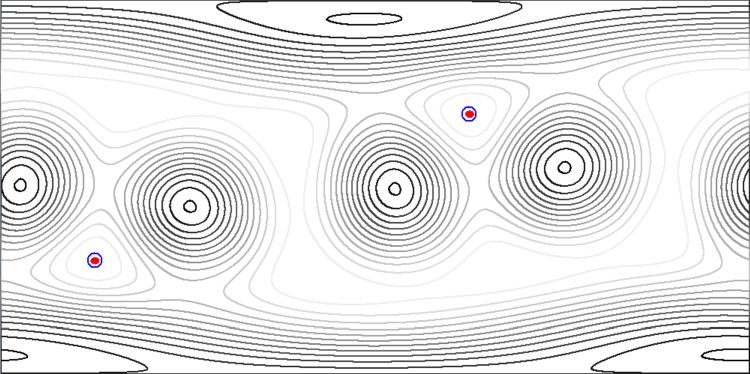Definition:
$$
f(x,y,z) = 4(x^6+y^6+z^6) + 5(x^5 y + y^5 z + z^5 x) - \frac{(x+y+z)^6}{27}
$$
We have to prove that $\;f(x,y,z) \ge 0\;$ for all $\;x,y,z \in {\bf R}$ .
For $\;x=y=z=r\;$ equality holds: $\;f(r,r,r)= 12 r^6 + 15 r^6 - (27^2 r^6)/27 = 0$ .
As has been noticed by user64494,
the problem is invariant for scaling the variables with a factor $t$ : if the statement is true
for $(x,y,z)$ then it is true for $(t x,t y,t z)$ as well. Meaning that, without loss of generality,
we can consider instead only normed solutions, with $t=1/\sqrt{x^2 + y^2 + z^2}$. That is: with $x=y=z=0$ as the only exception.
Note, however, that we have already covered this case with $f(r,r,r)=0$ where $r=0$ .
Therefore WLOG we can define an additional constraint $\,g\,$ for all $(x,y,z)$ with
$(x \ne 0) \vee (y \ne 0) \vee (z \ne 0)$ :
$$
g(x,y,z) = x^2 + y^2 + z^2 = 1
$$
In my answer
to a similar question, the following key reference is mentioned:
From this reference we have (again) the following
Theorem (The Purkiss Principle). Let $f$ and $g$ be symmetric functions with continuous
second derivatives in the neighborhood of a point $P = (r, \cdots, r)$. On the set where $g$
equals $g(P)$, the function $f$ will have a local maximum or minimum at $P$ except in
degenerate cases.
The functions $\;f(x,y,z)\;$ and $\;g(x,y,z)\;$ have already been defined accordingly.
Now $\;g(r,r,r) = 3r^2 = 1$ , hence the point $P\;$ is: $(r,r,r) = (1,1,1)/\sqrt{3}\;$ and $\;f(r,r,r) = 0\;$
must be a minimum or a maximum.
It's easy to show that the first and second derivatives of $f$ and $g$ are
like the examples in the paper - preceding the proof of the Theorem there; and obeying all of the Lemmas there
- thus preventing any exceptions to the Purkiss principle.
First order derivatives:
$$ \left[ \begin{array}{c}
\partial f / \partial x \\
\partial f / \partial y \\
\partial f / \partial z \end{array} \right] (r,r,r) =
\left[ \begin{array}{c} 0 \\ 0 \\ 0 \end{array} \right] =
\lambda \left[ \begin{array}{c} \partial g / \partial x \\
\partial g / \partial y \\
\partial g / \partial z
\end{array} \right] (r,r,r) = 0
\left[ \begin{array}{c} 2 r \\ 2 r \\ 2 r \end{array} \right]
$$
Second order derivatives:
$$ \left[ \begin{array}{ccc}
\partial^2 f/\partial x^2 & \partial^2 f/\partial x \partial y & \partial^2 f/\partial x \partial z \\
\partial^2 f/\partial x \partial y & \partial^2 f/\partial y^2 & \partial^2 f/\partial y \partial z \\
\partial^2 f/\partial x \partial z & \partial^2 f/\partial y \partial z & \partial^2 f/ \partial z^2
\end{array} \right] (r,r,r) =
\left[ \begin{array}{ccc}
130 r^4 & -64 r^4 & -64 r^4 \\
-64 r^4 & 130 r^4 & -64 r^4 \\
-64 r^4 & -64 r^4 & 130 r^4
\end{array} \right]$$
Similar structure, as required, in:
$$ \left[ \begin{array}{ccc}
\partial^2 g/\partial x^2 & \partial^2 g /\partial x \partial y & \partial^2 g/\partial x \partial z \\
\partial^2 g/\partial x \partial y & \partial^2 g/\partial y^2 & \partial^2 g/\partial y \partial z \\
\partial^2 g/\partial x \partial z & \partial^2 g/\partial y \partial z & \partial^2 g/ \partial z^2
\end{array} \right] (r,r,r) =
\left[ \begin{array}{ccc}
2 & 0 & 0 \\
0 & 2 & 0 \\
0 & 0 & 2
\end{array} \right]
$$
The form of the second order derivatives matrices guarantees that $\;f(r,r,r)\;$ must be a minimum.
Update in response to the comment by
David Speyer.
Due to the constraint $x^2+y^2+z^2=1$ the whole problem can be re-formulated in spherical
coordinates: $(x,y,z)=(\cos(\theta)\cos(\phi),\cos(\theta)\sin(\phi),\sin(\theta))$
with $-\pi/2<\theta<+\pi/2$ and $-\pi<\phi<+\pi$ . Substitute these into $f(x,y,z)$
and make a contour plot $(\phi,\theta)$ . We have done this for $f(x,y,z) = k/3 \; , \; k = 1,\cdots\,15$ .
Darker lines correspond with larger values of $f$ . Places where $f(x,y,z) < 0.01$ are
colored $\color{red}{red}$ and the places of the minima $\;\pm 1/\sqrt{3}(1,1,1)\;$
in spherical coordinates are indicated with a $\color{blue}{blue}$ circle.
We see that the circles and the red spots coincide and that the function values are uniformly decreasing
in the neighborhood of these.


